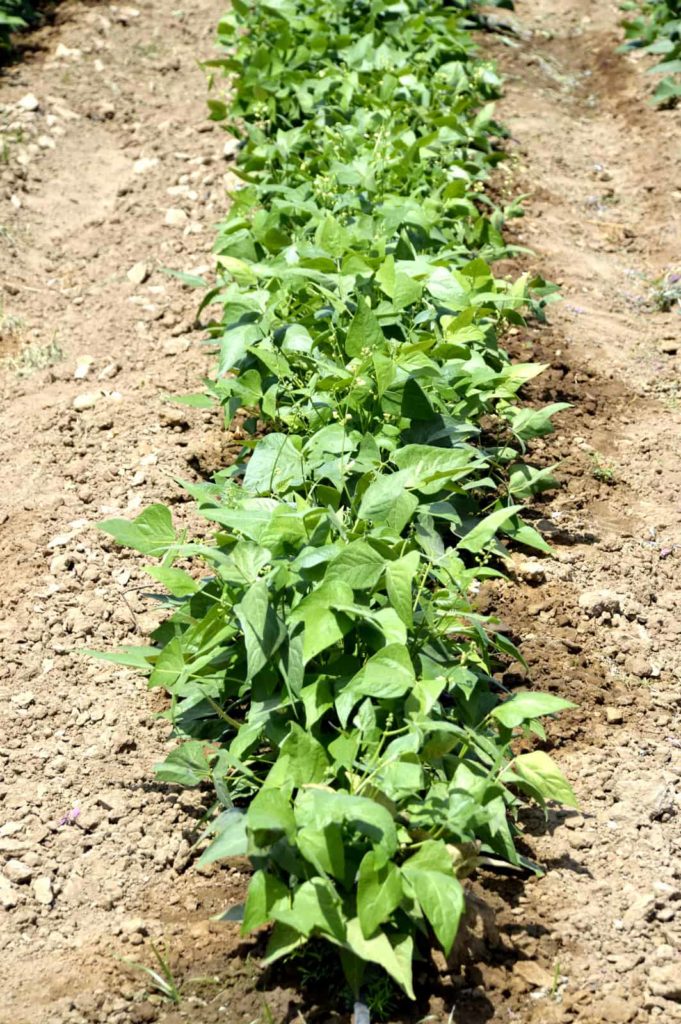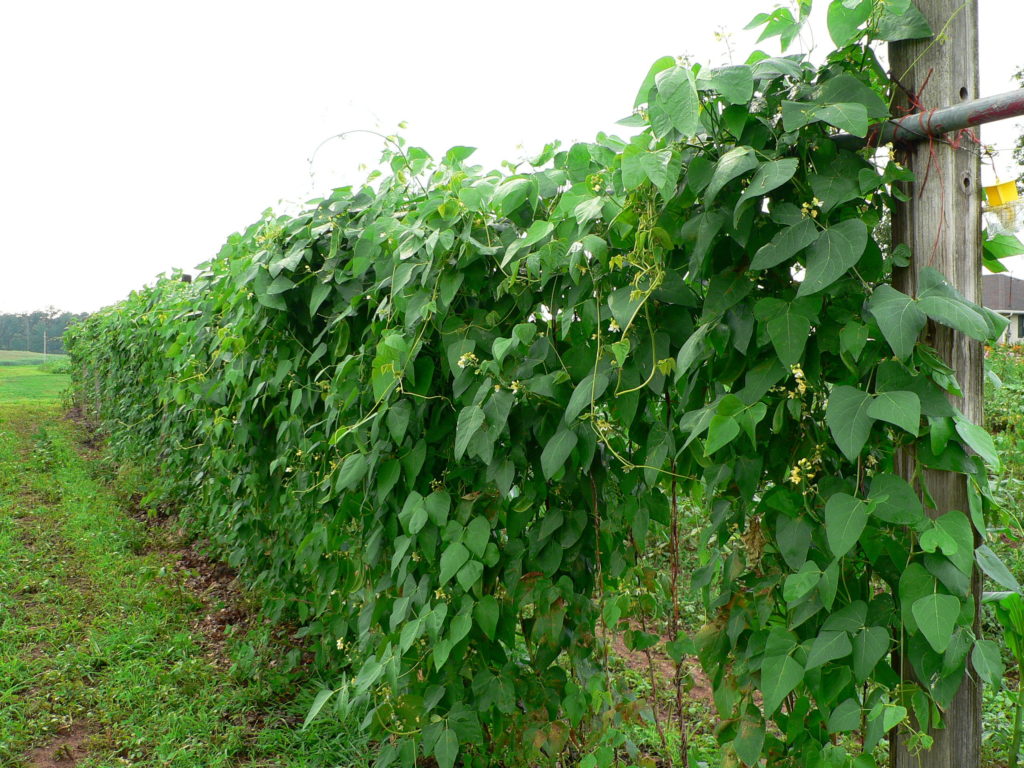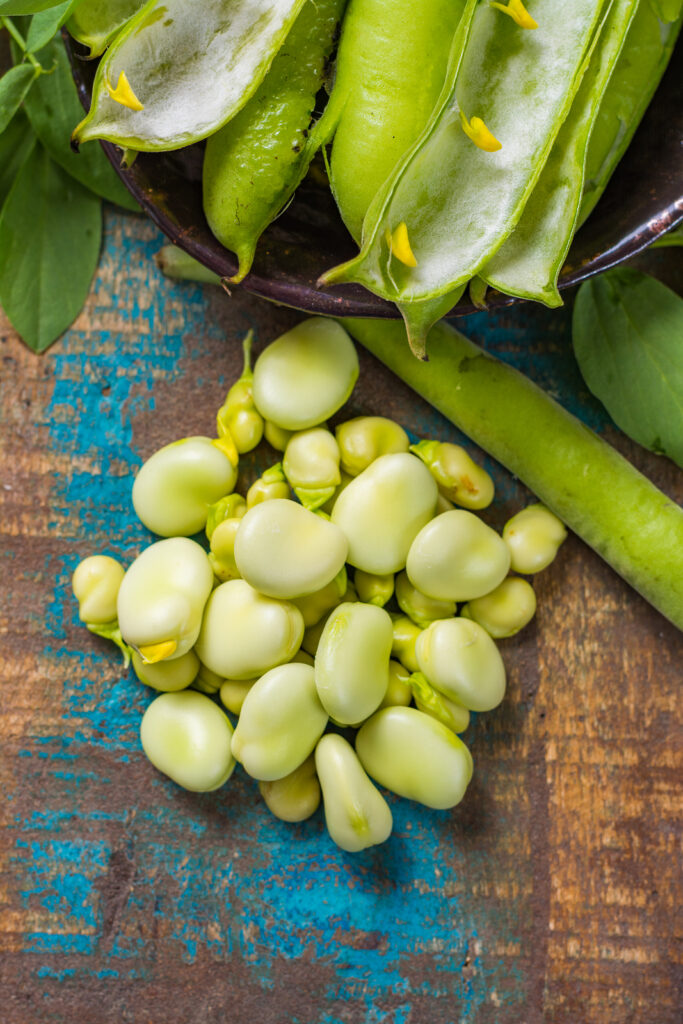Lima beans are tender annuals grown for their flat, crescent-oval-shaped seeds. There are two types of lima beans: bush and pole or vine varieties. Bush types grow to about 2 feet tall (.6m) and tend to have smaller seeds; they bear more quickly than pole lima bean varieties. Pole lima beans have large seeds and can grow 10 to 12 feet (3-3.6m) high.
Small-seeded limas, usually bush types, are also called butter beans, sieva beans, Burma beans, Madagascar beans, Carolina beans, and “baby limas.” Large-seeded lima beans are sometimes called potato limas. Large-seeded limas are often sold as dry beans.
Related articles:
- Shell Beans Serving Tips
- Five Ways to Cook and Serve Fava Beans
- How to Plant, Grow, and Harvest Fava Beans
Here is your complete guide to growing lima beans!
Lima Bean Quick Growing Tips
- Sow lima beans in the garden 3 to 4 weeks after the average date of the last frost in spring when the soil temperature has warmed to 65°F (18°C) or more for at least 5 days and daytime temperatures are consistently warm.
- Start lima beans indoors as early as 2 to 3 weeks before the average last frost date in spring for transplanting into the garden.
- Lima beans require 60 to more than 90 warm, frost-free days to reach harvest depending upon type and variety. Lima bean harvest occurs in late summer or fall.
- There are two types of lima bean plants: bush lima beans (grow to about 3 feet tall) and pole lima beans (grow 10 to 15 feet tall)
- Lima beans are self-pollinating; small, white, or violet flowers self-pollinate. Flowers are followed by 3 to 8 inches pods that contain 2 to 4 bean seeds.
- Lima beans are shallow-rooted plants; like other legumes, lima bean roots affix nitrogen in the soil.
- Lima bean seeds can be white with brown, purple, green, and blue.
Good Products for Growing Lima Beans at Amazon:
- Garden Safe Snail and Slug Bait
- Bonide Sulfur Fungicide
- Monterey BT Caterpillar Killer
- Neem Bliss 100-% Cold Pressed Neem Oil
- Safer Brand Insect Killing Soap
- PyGanic Botanical Insecticide

Where to Plant Lima Beans
- Grow lima beans in full sun; they will grow in partial shade but the harvest will not be full.
- Lima beans need 6 to 8 hours of direct sun each day for the best yield.
- Lima beans prefer loose, well-drained rich soil–soil rich in organic matter.
- Beans prefer a soil pH of 6.0 to 6.8. Do a soil test before planting.
- Prepare planting beds in advance by working in plenty of aged compost.
- Compacted soil can stunt lima bean growth; add sand, well-rotted manure, compost, or vermiculite.
- Avoid planting beans where soil nitrogen is high or where green manure crops have just grown; these beans will produce green foliage but few beans.
Good Products for Growing Your Garden
- 55 Heirloom Vegetable Varieties–27,500 Non GMO Seeds
- Heirloom Vegetable Seed Collection – 105 Varieties
- Full Spectrum, LED Grow Lights
- Seed Starter Kit with Humidity Dome (120 Cells Total Tray)
- Galvanized Raised Garden Bed with Cover
- Gardzen 10-Pack 10 Gallon Grow Bags
- Captain Jack’s Dead Bug Brew
- Harris Neem Oil Plant Disease Control
- Freeze Protection Garden Mesh Netting Kit
- Kitchen Garden Grower’s Guide Vegetable Encyclopedia
- Vegetable Garden Almanac & Planner
Lima Bean Planting Time
- Lima beans are a tender annual that grows best in air temperatures between 60° and 70°F (15-21°C). Some varieties are heat tolerant (up to 110°F) and some are cold tolerant.
- Sow lima beans in the garden 3 to 4 weeks after the average date of the last frost in spring when the soil temperature has warmed to 65°F (18°C) or more for at least 5 days.
- Start lima beans indoors as early as 2 or 3 weeks before the average last frost date in spring for transplanting into the garden 3 or 4 weeks after the last frost. Start beans indoors in biodegradable peat pots or paper pots that can be set whole into the garden so as not to disturb plant roots.
- For continuous harvest through the growing season, sow succession crop bush lima beans every two weeks or follow bush lima beans with long-maturing pole lima beans.
- Lima beans can continue in the garden until the first frost in fall.
- Pole lima beans require a long growing period and are not a good choice where the season is short.
- Lima beans will not set pods in temperatures above 80°F (26°C) or in cold or wet weather. Time your plantings to avoid hot weather.
- In mild-winter regions, lima beans can be sown in autumn for winter harvest.
Planting and Spacing Lima Beans
- Sow lima beans 1½ to 2 inches (4-5cm) deep.
- Plant bush lima beans 3 to 6 inches (7-15cm) apart; set rows 24 to 30 inches (61-76cm) apart. Bush lima beans do not need support.
- Plant pole lima beans 6 to 10 inches (15-25cm) apart; set rows 30 to 36 inches (76-91cm) apart. Pole lima beans need support. Set poles, stakes, or supports in place at planting time.
- Pole beans also can be planted in inverted hills–5 or 6 seeds to a hill; space hills 40 inches (101cm) apart.
- Sow one seed per hole. Germination will occur in 1 to 3 weeks.
- Thin strong seedlings from 4 to 6 inches (10-15cm) apart. Remove weaker seedlings by cutting them off at soil level with scissors being careful not to disturb the roots of other seedlings.
- Lima beans can be crowded; they will use each other for support.
- Lima bean yield: grow 4 to 8 lima bean plants per household member.
- Avoid planting lima beans with other nitrogen-setting legumes such as fava beans or green beans; all affix nitrogen in the soil; too much nitrogen can hinder pod formation.
Lima Bean Companion Plants
- Grow Bush lima beans with bush beans, cucumbers, corn, cucumbers, celery, potatoes, and summer savory.
- Grow pole lima beans with corn, scarlet runner beans, summer savory, and sunflowers.
- Do not plant beans with onions, beets, or kohlrabi.
Container Growing Lima Beans
- Bush lima beans can be grown in containers, but you may need several containers for a practical harvest.
- Lima beans will grow in 8-inch containers.

Watering and Feeding Lima Beans
- Grow lima beans in soil that is evenly moist and well-drained. Bean seeds may crack and germinate poorly if the soil moisture is too high at sowing.
- Do not soak seeds in advance of planting or they may crack; do not over-water after sowing.
- Keep the soil evenly moist during flowering and pod formation.
- An inch of water once a week is sufficient in mild weather. Water at the base of the plant.
- Rain or overhead irrigation during flowering can cause flowers and small pods to fall off. Drip irrigation at the base of the plant is best.
- Once the soil temperature averages greater than 60°F (16°C), mulch to conserve moisture.
- Beans are best fertilized with aged garden compost; they do not require extra nitrogen. Beans set up a mutual exchange with soil microorganisms called nitrogen-fixing bacteria that produce the soil nitrogen beans require.
- Avoid using green manures or nitrogen-rich fertilizers.
Lima Bean Care and Maintenance
- Large lima bean seeds may have trouble pushing through soil that has not been well worked; at sowing, cover the seeds with sand, vermiculite, or an aged compost-vermiculite mix instead.
- Cultivate around beans carefully to avoid disturbing the shallow root system.
- Do not handle beans when they are wet; this may spread fungus spores.
- Set poles, stakes, or trellises in place before planting pole beans. Select supports that are tall enough for the variety being grown.
- Toward the end of the season pinch back plant growing tips to direct the plant’s energy into ripening the remaining pods.
- Rotate beans to plots where lettuce, squash, broccoli, Brussels sprouts, cabbage, cauliflower, or collards have grown in the past year or two.
Lima Bean Pests
- Lima beans can be attacked by common pests found in the vegetable garden–aphids, bean beetles, flea beetles, leafhoppers, and spider mites.
- Aphids, leafhoppers, and mites can be sprayed away with a blast of water from the hose or controlled with insecticidal soap. Look for eggs and infestations and crush them between your fingers and thumb. Pinch out and remove large infestations.
- Aphids can spread the bean mosaic virus.
- Bean beetles will eat leaves; exclude bean beetles by covering plants with row covers. They can also be killed with Neem oil.
- Bean leaf beetles feed on leaves and chew hold through pods; the larva feeds on bean plant roots. Use row covers to exclude bean leaf beetles or kill them with Pyrethrin spray.
- Corn earworms feed on bean leaves, vines, and stems; handpick and drown corn earworms in soapy water or spray plants with Bacillus thuringiensis (Bt).
- Keep the garden clean and free of debris so that pests can not harbor or overwinter in the garden.
Lima Bean Diseases
- Lima beans are susceptible to powdery mildew, blight, bean mosaic virus, and anthracnose. Plant disease-resistant varieties.
- Remove the leaves of plants infected with powdery mildew; prevent powdery mildew by spring plants with neem oil or copper fungicide sprays.
- Bean mosaic virus causes leaves to become mottled; mosaic virus is spread by aphids. Remove infected plants; there is no cure for the bean mosaic virus.
- Keep the garden clean and free of debris.
- Avoid handling plants when they are wet so as not to spread fungal spores.
- Remove diseased plants; put them in a paper bag and throw them away.
- Beans are susceptible to many soil-borne diseases; rotating beans so that they do not grow in the same location more than every three years will reduce soil-borne diseases.
How to Harvest Lima Beans
- Bush lima beans will be ready for harvest 60 to 80 after sowing; pole beans will be ready for harvest 85 to 90 days after sowing seed.
- Pick lima beans when the seed pods are plump and firm. Continue to pick pods as soon as they become plump to extend flowering and the production of new pods. When seeds mature, the plant will die.
- Pods left too long will result in seeds that are tough and mealy.
- Bush lima beans should produce 2 or 3 pickings in a season.
- Dried beans can be harvested after the plant turns brown and dries up.
- As the end of the season nears, nip off growing tips which will allow the plant to direct its energy into ripening the remaining beans.
- Lima beans are perennial plants; cut them back before the first freeze and cover the plant with mulch; where winters are not too cold, plants will regrow in spring.

Storing and Preserving Lima Beans
- Unshelled lima beans will keep in the refrigerator for one week.
- Shelled lima beans can be blanched and frozen for up to 3 months.
- Dried and shelled limas can be stored in a cool, dry place for 10 to 12 months. Seal dried beans in a plastic bag and place the bag in the freezer for 48 hours; this will kill insects or insect eggs. Beans can also be dried on a cookie sheet at 160°F for 30 minutes.
- Lima beans can be dried after harvest; place them in a dehydrator or set them in a well-ventilated, cool place until they are hard to the touch.
- Canned lima beans can be stored for 1 year. Frozen lima beans can be stored for 9 months. Dried lima beans can be stored for 9 months at room temperature in an airtight container or plastic bag.
- Lima bean seeds are not edible seeds raw. Raw lima beans contain a compound called linamarin, which turns into cyanide when consumed. Lima beans should be cooked before eating.
Lima Bean Varieties and Cultivars to Grow
- Pole lima beans: ‘Aubrey Deane’ (87 days); ‘Carolina’ (79 days); ‘Christmas’ (88 days); ‘Florida Butter’ (85 days); ‘Illinois Giant’ (86 days); ‘King of the Garden’ (90 days); ‘Prizetaker’ (90 days).
- Bush lima beans (plump seeded): ‘Excel Northern Fresh’ (72 days); ‘Fordhook Improved’ (75 days); ‘Potato Lima’ (75 days).
- Bush lima beans (small-seeded): ‘Baby Bush’ (67 days); ‘Henderson Bush’ (65 days); ‘Jackson Wonder’ (65 days), ‘Willow-Leaf White’ (86 days).
- For succession planting grow ‘Henderson Bush’, a quick grower.
- Scarlet runner beans (70 days) are pole lima beans; scarlet runner beans have bright purple or deep red beans inside light green pods.
About Lima Beans
- Lima beans are legumes; they are related to snap beans. Lima bean pods are pale green pods and vary from 3 to 4 inches (7-10cm) long to 5 to 8 inches (12-20cm) long depending upon the variety. Lima bean seeds are eaten, not the pods. Leaves are commonly composed of three leaflets and the flowers are white. Bush lima bean varieties are ready for harvest from 60 to 80 days from sowing; pole bean varieties are ready for harvest in 85 to 90 days.
- Common name. Bean, lima bean, butter bean, sieva bean, chad bean, wax bean, Burma bean, double bean, Madagascar bean
- Botanical name. Phaseolus lunatus
- Origin. South Mexico, Central America; lima beans have been cultivated for more than 4,000 years.
- Days to harvest: 65 to 90 days
- Light: Full sun
- Water: 1 inch per week
- Soil: Rich, loose, well-draining
- Fertilizer: Aged compost or aged manure
Related articles:
How to Plant and Grow Snap Beans
How to Harvest and Store Snap Beans
Bean Growing Problems: Troubleshooting
Five Ways to Quick Cook and Serve Snap Beans
How to Can Green Snap Beans for Beginners
Cooking and Serving Yard-Long Beans
How to Grow Plant, Grow, and Harvest Chickpeas and Garbanzo Beans
How to Cook and Serve Chickpeas
How to Plant, Grow, and Harvest Lima Beans
How to Plant, Grow, and Harvest Broad Beans and Fava Beans
Five Ways to Cook and Serve Fava Beans
All About Dried Beans – Growing and Cooking
Container Growing Beans – Plant, Grow, and Harvest Tips
Garden Planning Books at Amazon:
- Vegetable Garden Almanac & Planner
- Kitchen Garden Grower’s Guide Vegetable Encyclopedia
- Tomato Grower’s Answer Book
- Vegetable Garden Grower’s Guide
More how to grow articles:
Learn how to plant, grow, and harvest your favorite vegetables. Click below for all you need to know.
- Artichoke
- Arugula
- Asparagus
- Beans, Snap
- Beets
- Broad Beans
- Broccoli
- Brussels Sprouts
- Cabbage
- Cantaloupe — Melons
- Cardoon
- Carrots
- Cauliflower
- Celeriac
- Celery
- Chard
- Chayote Squash
- Chickpeas
- Chicory
- Chinese Cabbage
- Collards
- Corn Salad
- Corn, Sweet
- Cresses
- Cucumbers
- Eggplant
- Endive and Escarole
- Fava Beans
- Florence Fennel
- Garbanzo Beans
- Garlic
- Horseradish
- Jerusalem Artichoke
- Kale
- Kohlrabi
- Leeks
- Lettuce
- Lima Beans
- Melons
- Mizuna
- Mustard Greens
- New Zealand Spinach
- Okra
- Onions
- Parsnips
- Peanuts
- Peas
- Peppers
- Potatoes
- Pumpkins
- Radicchio
- Radishes
- Rhubarb
- Rutabaga
- Salsify
- Shallots
- Sorrel
- Southern Peas
- Soybeans
- Spinach
- Squash, Summer
- Squash, Winter
- Sunchokes
- Sweet Potato
- Swiss Chard
- Taro
- Tomatillo
- Tomatoes
- Turnips
- Watermelon
- Zucchini















